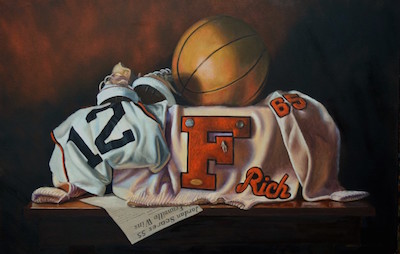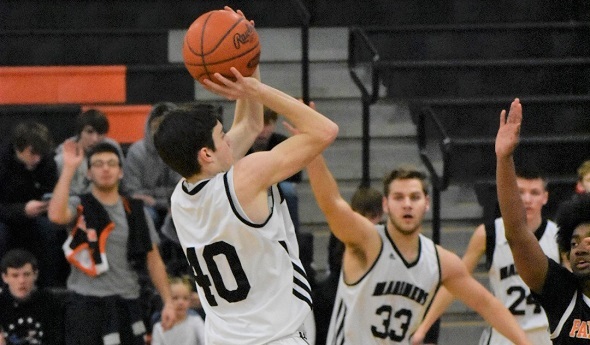
Film Fills In Picture of 'Fennville Flash'
By
Ron Pesch
MHSAA historian
December 28, 2017
We’ve been here before, but not in this way.
The last time was for a retrospective, covering one of the most impressive and awe-inspiring prep careers in Michigan high school history. That time was in print, and included a handful of still images that tried to illustrate the unbelievable.
But this time, the story is in documentary form. It’s woven together from grainy, scratched, faded silent film, a format of capturing memories familiar to thousands of people from generations past, as well as a series of modern-day high-resolution interviews.
Here, the basketball life of the athlete known as the “Fennville Flash” delivers on many levels. Yes, there is a Richie Jordan.
JordanVille, a documentary by John Mooy & Anne Colton, recalls a time when legend spread via word of mouth, newsprint and AM radio.
While it’s hard to comprehend for many today, the exploits of our athletic heroes were formed by “poets in the press box” who sat with pencil and paper, a typewriter, a microphone or a telephone, and described to their audience what they witnessed. On the receiving end, readers and listeners conjured up visualizations based on the facts, phrases and superlatives designed to create an image.
“Traveling left to right on your radio dial” helped listeners feel they were a member of the crowd, seated in the stands, in on the action and a witness to the mayhem. “Packed to the rafters,” reminded fans the importance of what was happening. An exciting game, presented by those with skill, created an event you longed to see. If a broadcast couldn’t be picked up on a transistor or tube radio, the final result might not be known, at the earliest, until the following day’s newspaper arrived.
I’ve told Jordan’s story via the MHSAA before; how he latched on to athletic training, weights and repetition to mold himself into a well-rounded athlete, able to leap to heights unexpected for a kid with a 5-foot-7 frame. The tales of his unfathomable accomplishments slowly leaked beyond the city limits of Fennville into Kalamazoo and greater Southwestern Michigan, then to Detroit. When Detroit Free Press writer Hal Schram relayed Jordan’s feats, the secret traveled across the state and beyond its drawn borders.
From there the legend of Jordan’s accomplishments grew. In Fennville, as in many small towns across the country, the city shut down when a game was played. The Jordan story was so enticing that thousands would travel vast distances to see him play with their own eyes. Today, his single season scoring average of 44.4 points per game during the 1964-65 campaign still remains the top mark in the MHSAA record book.
 JordanVille runs just shy of a half hour. Contained within is insight into the athlete that is challenging to relay in print form. Thanks to access to home movies and a series of interviews with Jordan, former teammates, past opponents and his high school coach, the determination, dedication and drive of a kid who wouldn’t let physical size be a deterrent from achievement radiates from the screen. On display is small town America at its finest, and perspective formed over 50+ years.
JordanVille runs just shy of a half hour. Contained within is insight into the athlete that is challenging to relay in print form. Thanks to access to home movies and a series of interviews with Jordan, former teammates, past opponents and his high school coach, the determination, dedication and drive of a kid who wouldn’t let physical size be a deterrent from achievement radiates from the screen. On display is small town America at its finest, and perspective formed over 50+ years.
For Mooy, it completes a filmmaking journey started six years ago. But the story of Jordan, in his eyes, date back to his school days. Mooy first heard about Jordan as a 7th-grader from a math teacher. A second-team all-St. Joseph Valley League selection, Mooy played at Marcellus High School and scrimmaged against Jordan and the Fennville Blackhawks.
He couldn’t believe his eyes.
“Everyone wanted to see this kid play,” said Mooy in 2011. “He was the first high school player I saw sign an autograph.
Today, with the interviews complete, and the film ready for viewing, Mooy sees more than just a sports story:
“With the benefit of years now passed, I look at the Rich Jordan story with a new respect. JordanVille created a place that was welcoming no matter who you were, or what color your skin happened to be. It was the 1960s. Rich was growing up Jewish, the Civil Rights Movement was in full swing, and the Vietnam War was on everyone's mind. And in Fennville, Michigan, from 1961 to 1965, the Jordan high school years, there were lessons beyond sports being learned by everyone that would last a lifetime. The Jordan household, under the guidance of (his parents) Tuffy and Sylvia Jordan, is where the story begins."
The film speaks of a time that has departed. Competition for our attention was less focused; phones hung on walls or sat on tabletops, communities were tighter, the training table featured peanut butter and chocolate milk instead of protein powder. A city could easily be renamed for a day.
The film also reminds us that those days were far from perfect.
If all goes as planned, the public will see the finished product come the flip of the calendar. In West Michigan, JordanVille is scheduled to show on New Year’s Day at 6 p.m. on WGVU, and will repeat on WGVU-Life at 7:30 p.m., Friday, Jan. 5.
Seek it out, and spread the word, just like in days of old.
 Ron Pesch has taken an active role in researching the history of MHSAA events since 1985 and began writing for MHSAA Finals programs in 1986, adding additional features and "flashbacks" in 1992. He inherited the title of MHSAA historian from the late Dick Kishpaugh following the 1993-94 school year, and resides in Muskegon. Contact him at [email protected] with ideas for historical articles.
Ron Pesch has taken an active role in researching the history of MHSAA events since 1985 and began writing for MHSAA Finals programs in 1986, adding additional features and "flashbacks" in 1992. He inherited the title of MHSAA historian from the late Dick Kishpaugh following the 1993-94 school year, and resides in Muskegon. Contact him at [email protected] with ideas for historical articles.
PHOTOS: (Top) Richie Jordan runs Fennville's offense during his thrilling high school career in the 1960s. (Middle) Jordan memorabilia, as captured by Bill Williams.

Marine City Rising Under Familiar Leader
By
Paul Costanzo
Special for MHSAA.com
January 30, 2019
Championship celebrations aren’t unfamiliar in Marine City. It’s just that they typically don’t happen after a boys basketball game.
 The town most known for its football prowess is experiencing some extra excitement this winter, as the basketball program – now led by the same man who leads the football program, coach Ron Glodich – is seeing success it hasn’t seen in decades.
The town most known for its football prowess is experiencing some extra excitement this winter, as the basketball program – now led by the same man who leads the football program, coach Ron Glodich – is seeing success it hasn’t seen in decades.
On Jan. 22, the Mariners boys basketball team clinched its first conference title since 1985, and three nights later, after another Macomb Area Conference Bronze win, they cut down the nets in their home gym.
“It was a great feeling, because I’m going to keep that net for the rest of my life,” Marine City junior Angelo Patsalis said. “When I look back at it, I’ll know this team was special.”
The Mariners were 10-2 overall and 7-0 in the MAC Bronze through January, and are changing the way people feel about their program. Now big, raucous crowds aren’t limited to just fall Fridays at East China Stadium.
“It’s definitely starting to change,” senior point guard Jack Kretzschmar said. “We didn’t really used to get a lot of people at home games because people just assumed we were going to lose. Now everyone is starting to show up, and the atmosphere they’re bringing to basketball is crazy.”
It’s no coincidence that Glodich, who has had multiple roles in Marine City athletics since taking a job at the school in 1987, is a common thread between the programs.
 Most of his success has come on the football field, where he’s been head coach since 2012, and was the offensive coordinator prior to that, as the team won Division 4 championships in 2007 and 2013 and made several other deep playoff runs. He’s also coached volleyball and baseball and had a previous stint as the boys basketball coach during the early 2000s.
Most of his success has come on the football field, where he’s been head coach since 2012, and was the offensive coordinator prior to that, as the team won Division 4 championships in 2007 and 2013 and made several other deep playoff runs. He’s also coached volleyball and baseball and had a previous stint as the boys basketball coach during the early 2000s.
For the football players who also play basketball at Marine City, they knew exactly what to expect when Glodich took over.
“It’s the same guy,” Patsalis said. “If we’re in halftime and down by a couple points and not playing well, he still gets pretty fired up. The intensity kind of helps, because it fires you up to be better and pushes you to get to your potential.”
While each sport has its own quirks, Glodich has been able to apply many of his same coaching philosophies no matter which ball is in play.
“One of the things that stays consistent (from sport to sport) is the way we practice,” Glodich said. “We believe in high tempo, fast-paced practices. We break things down to bits and pieces and work on them, and that stays consistent. Getting into a good stance, that’s a commonality in all sports.”
A commonality between Glodich’s football and basketball methods is movement on offense, and just like it has done for decades on the gridiron, it’s having success now on the court.
“We know how to score and how to get kids moving, which makes us difficult to defend,” Glodich said. “We have one base offense, but we have some wrinkles going on. This group has some very good team speed, and we’re trying to put pressure on defenses, not letting them get settled.”
That speed also allows the Mariners to run, making up for a lack of size as the Mariners’ tallest player stands at just 6 feet, 4 inches.
 “Even the drills we do in practice, basically we’re always running, and that correlates to the games,” Kretzschmar said. “Everyone on our team has such a high basketball IQ and we have a lot of chemistry built in over the last few years, so we know that we’re best when we’re running.”
“Even the drills we do in practice, basically we’re always running, and that correlates to the games,” Kretzschmar said. “Everyone on our team has such a high basketball IQ and we have a lot of chemistry built in over the last few years, so we know that we’re best when we’re running.”
That strategy helped make it a bit easier to transition from a football season that ended in the Division 5 Semifinals to the opening night of hoops in less than two weeks.
“Football got us conditioned, so we were already conditioned when we started the season,” Patsalis said. “When we got against that first team, we were ready to go.”
Glodich’s strong supporting staff also played a large role.
“Thankfully, I have a wonderful JV coach in Scott Hand,” Glodich said. “Not only did we go deep into the season with football, but basketball started a week early. In November, I had shoulder surgery, so it’s been a blessing to have such a wonderful JV coach who could handle things.”
The strong start never really stopped, as even the Mariners’ two losses came in double overtime against rival St. Clair, and to a 13-1 Richmond team. Winning the conference title was just the start, as there’s plenty more to play for the rest of the season.
“After Tuesday of next week, we get into the MAC tournament, so the Bronze and the Silver have four teams from each cross over in a three-game tournament,” Glodich said. “We would like to show that the Bronze, even though we’re the bottom level of the MAC, have a level of play that’s as competitive as the next league. Then, obviously, we move on to the District.”
There’s a long way to go, but the Mariners hope to at least continue building Marine City’s reputation as more than a football school.
“We kind of have a chip on our shoulder, because we’ve been known as a ‘football’ school for so long; we’re looking to bring that to basketball,” Kretzschmar said. “I think it’s just a special group of kids that we have, and everyone is trying to kind of change the culture to being an ‘athletic’ school.”
 Paul Costanzo served as a sportswriter at The Port Huron Times Herald from 2006-15, including three years as lead sportswriter, and prior to that as sports editor at the Hillsdale Daily News from 2005-06. He can be reached at [email protected] with story ideas for Genesee, Lapeer, St. Clair, Sanilac, Huron, Tuscola, Saginaw, Bay, Arenac, Midland and Gladwin counties.
Paul Costanzo served as a sportswriter at The Port Huron Times Herald from 2006-15, including three years as lead sportswriter, and prior to that as sports editor at the Hillsdale Daily News from 2005-06. He can be reached at [email protected] with story ideas for Genesee, Lapeer, St. Clair, Sanilac, Huron, Tuscola, Saginaw, Bay, Arenac, Midland and Gladwin counties.
PHOTOS: (Top) Marine City’s Reese Adamczyk (40) pulls up for a jumper during last week’s win over Center Line. (Middle) Mariners coach Ron Glodich. (Below) Tanner Mason (33) muscles for a shot in the post. (Action photos by Ally Swantek.)

